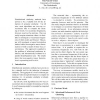444 search results - page 4 / 89 » Evaluating and Combining Approaches to Selectional Preferenc... |
81
Voted
COGSCI
2002
14 years 11 months ago
2002
Selectional preferences have a long history in both generative and computational linguistics. However, since the publication of Resnik's dissertation in 1993, a new approach ...
99
Voted
VLDB
2004
ACM
15 years 5 months ago
2004
ACM
Declarative queries are proving to be an attractive paradigm for interacting with networks of wireless sensors. The metaphor that “the sensornet is a database” is problematic,...
104
click to vote
EMNLP
2008
15 years 1 months ago
2008
We present a discriminative method for learning selectional preferences from unlabeled text. Positive examples are taken from observed predicate-argument pairs, while negatives ar...
93
Voted
NLE
2010
14 years 10 months ago
2010
Distributional similarity methods have proven to be a valuable tool for the induction of semantic similarity. Up till now, most algorithms use two-way cooccurrence data to compute...
CORR
2006
Springer
14 years 11 months ago
2006
Springer
Through the Internet and the World-Wide Web, a vast number of information sources has become available, which offer information on various subjects by different providers, often i...


